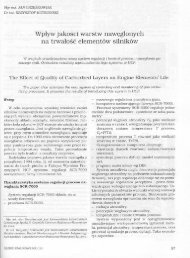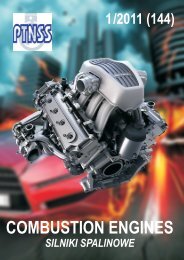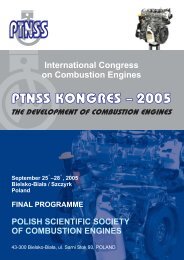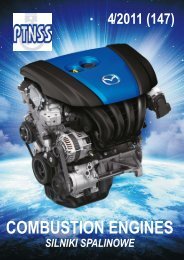You also want an ePaper? Increase the reach of your titles
YUMPU automatically turns print PDFs into web optimized ePapers that Google loves.
Źródła zanieczyszczeń i uszkodzeń części przepływowej okrętowego turbinowego...<br />
the engine with the intake air. A drop in the evenness of the<br />
shape of the vanes occurs and increased roughness occurs<br />
in their concave parts.<br />
It is quite frequent and hazardous for the engine that during<br />
winter operation intense erosive wear occurs of the compressor<br />
vanes (intake stages in particular) caused by the presence of<br />
ice solids detached from the iced air intakes [7].<br />
The engine turbines are also prone to erosion of the flow<br />
channels. This process (abrasive erosion) is related to the<br />
formation of hard, charred particles in the products of incomplete<br />
combustion. The greatest wear occurs then in the vanes<br />
(cutting edges) of the first stage of the high-pressure turbine.<br />
Fig. 7 presents the cutting edge of the high-pressure turbine<br />
guide vane recorded during the endoscopic examinations.<br />
The intensity of the erosive processes in the flow part is a<br />
function of the kinetic energy of the particles, the condition<br />
of the surface and the hardness of the construction material<br />
as well as the angle of attack of the flowing working medium<br />
on the channel. The destructive consequences of the erosive<br />
wear are additionally augmented by the corrosion processes.<br />
As a consequence, the efficiency of the individual flow machines<br />
and the strength properties of the vanes are reduced,<br />
which may cause local increase in the tension concentration<br />
as well as formation and development of micro cracks until<br />
complete destruction (breaking) of the vane.<br />
4. The influence of the deposit layer on the operating<br />
parameters of the compressor and turbines<br />
The layers of salt, tar and other contaminants that deposit<br />
on the surfaces of the flow part of the compressors and turbines<br />
with varied intensity modify the shape and geometry<br />
of the vanes, the shape of the flow channels and the structure<br />
of the surfaces. It is significant, particularly for the compressors<br />
that the increase in the values of the roughness of the<br />
vane surface reaches several times (see Fig. 3). In a brand<br />
new engine the arithmetic average deviation of the profile<br />
from the average line of the profile marked as Ra does not<br />
exceed one micrometer [11]. During the operation of the<br />
engine between overhauls this parameter value grows up to<br />
several tens of micrometers [8]. For the turbines the growth<br />
in the Ra value triggered by the formation of a deposit may<br />
reach up to several micrometers. The results of the increased<br />
roughness of the surface is in each case a growth of the flow<br />
resistance and as a result – reduced efficiency of the rotor<br />
assembly of the contaminated compressors and turbines.<br />
An example dependence of the changes in the efficiency<br />
of the flow machines of a turbine engine as a function of<br />
the average arithmetic profile deviation from the average<br />
line of that profile on the length of the elementary portion<br />
le of the rotor and the guide vane surfaces has been shown<br />
in Fig. 8.<br />
When analyzing the influence of the contamination of<br />
the flow channels on the characteristics of the compressor<br />
of a turbine engine we need to distinguish two possibilities<br />
that determine these characteristics:<br />
– channel contamination i.e. flow channel upstream or<br />
downstream the compressor,<br />
silników spalinowych i bardzo niebezpieczne w skutkach jest<br />
intensywne zużycie erozyjne łopatek sprężarki, szczególnie<br />
stopni wlotowych, wywołane obecnością kryształków lodu<br />
odrywanych z oblodzonych wlotów powietrza [7].<br />
Turbiny silnika są również narażone na zużycie erozyjne<br />
powierzchni kanałów przepływowych. Proces ten (erozja<br />
ścierna) związany jest z tworzeniem twardych, zwęglonych<br />
cząsteczek w produktach niecałkowitego spalania paliwa<br />
w komorze spalania. W największym stopniu zużywają się<br />
wówczas łopatki pierwszego stopnia turbiny wysokiego ciśnienia,<br />
szczególnie na ich krawędziach natarcia. Na rysunku<br />
7 przedstawiono, zarejestrowaną w czasie badań endoskopowych<br />
silnika w bieżącej eksploatacji, krawędź natarcia<br />
łopatki kierowniczej turbiny wysokiego ciśnienia.<br />
Intensywność procesów erozyjnych w części przepływowej<br />
silnika jest funkcją energii kinetycznej cząsteczek, stanu<br />
powierzchni i twardości materiału konstrukcyjnego oraz kąta<br />
natarcia strumienia przepływającego czynnika roboczego na<br />
powierzchnię kanału. Destrukcyjne konsekwencje zużycia<br />
erozyjnego dodatkowo pogłębia oddziaływanie procesów<br />
korozyjnych. W konsekwencji obniżają się sprawności poszczególnych<br />
maszyn przepływowych, a także właściwości<br />
wytrzymałościowe materiału łopatek, co może spowodować<br />
miejscowy wzrost koncentracji naprężeń, powstawanie i<br />
rozwój mikropęknięć, aż do całkowitego zniszczenia (ułamania)<br />
łopatki.<br />
4. Wpływ warstwy osadu na parametry pracy<br />
sprężarek i turbin<br />
Warstwa soli, nagaru i innych zanieczyszczeń, które<br />
podczas użytkowania silnika z różnym natężeniem osadzają<br />
się na powierzchniach części przepływowej sprężarek<br />
i turbin, zmieniają kształt i wymiary geometryczne<br />
łopatek, kształt kanałów przepływowych i chropowatość<br />
powierzchni. Bardzo istotne, i to szczególnie w odniesieniu<br />
do sprężarek, jest kilkakrotne nawet zwiększenie wartości<br />
parametrów charakteryzujących chropowatość powierzchni<br />
profilu łopatki (patrz rys. 3). W fabrycznie nowym silniku<br />
średnie arytmetyczne odchylenie profilu od linii średniej<br />
tego profilu, oznaczane jako Ra, nie przekracza jednego<br />
mikrometra [11]. W czasie międzyremontowego okresu<br />
eksploatacyjnego parametr ten zwiększa swoja wartość nawet<br />
do kilkudziesięciu mikrometrów [8]. Dla turbin wzrost<br />
wartości Ra wywołany powstawaniem osadu wynosić może<br />
nawet kilkaset mikrometrów. Rezultatem wzrostu wartości<br />
parametrów chropowatości powierzchni jest w każdym<br />
przypadku wzrost oporów przepływu i w rezultacie – obniżenie<br />
sprawności palisad łopatkowych zanieczyszczonych<br />
sprężarek i turbin.<br />
Przykładową zależność zmian sprawności maszyn przepływowych<br />
silnika turbinowego, jako funkcję średniego<br />
arytmetycznego odchylenia profilu od linii średniej tego<br />
profilu mierzone na długości odcinka elementarnego le<br />
powierzchni łopatek wirnikowych i kierowniczych przedstawiono<br />
na rys. 8.<br />
Rozpatrując wpływ zanieczyszczenia kanałów przepływowych<br />
na charakterystykę sprężarki turbinowego silnika<br />
16 <strong>COMBUSTION</strong> <strong>ENGINES</strong>, No. 4/2012 (151)












